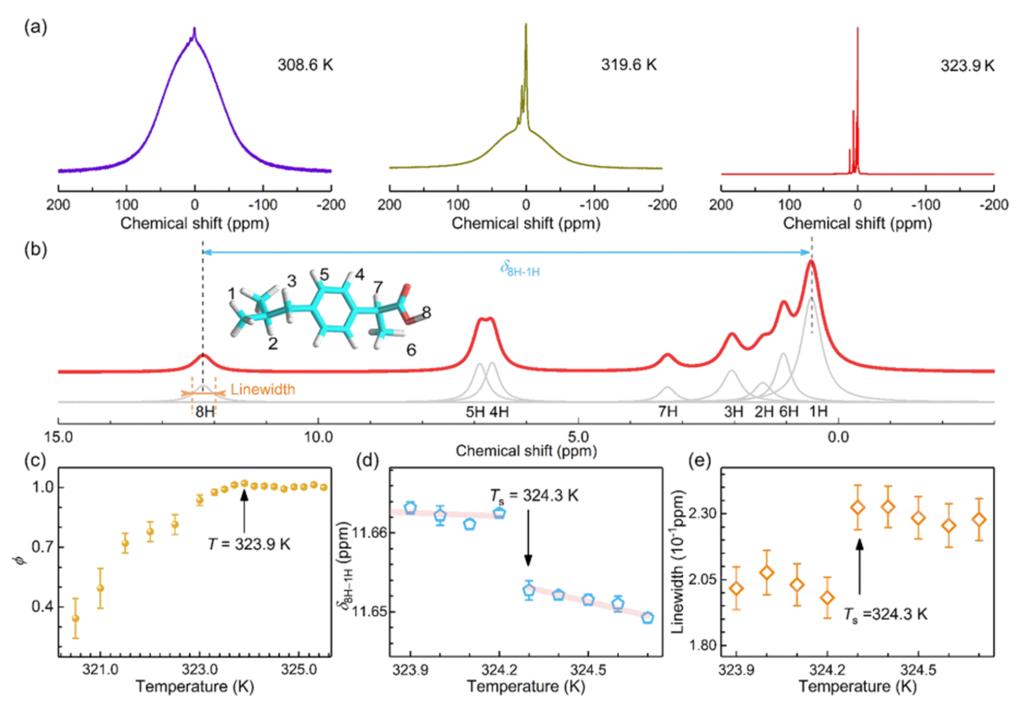
Cover: Illustration of two-step melting. The crystals firstly collapse into the crystalline fragments and then gradually transform into a liquid presented by the floating solid-like fragments, which exhibits the similarity of the crystals. Finally, such an intermediate liquid transforms into a normal disordered liquid state that is presented by the liquid ripple.

Figure 1. Melting process of SIBP studied by NMR. (a) Static 1H spectrum acquired at different temperatures. (b) The static 1H NMR spectrum acquired at 323.9 K. The hydrogen atoms of eight different chemical environments are labeled. The line width of the 8H peak and Δδ8Η−1Η are indicated. The inset shows the molecular structure of SIBP. White, cyan, and red represent hydrogen, carbon, and oxygen, respectively. (c) Fraction of liquid ϕ vs temperature. (d) Δδ8Η−1Η vs temperature, fitted with pink lines. (e) Line width vs temperature, fitted with gray lines.
Background
Unraveling the complete mechanism of three-dimensional crystal melting has been one of the core challenges in the field of condensed matter physics, primarily due to the difficulty in determining whether the crystal transitions into a disordered liquid through a continuous phase change. The majority of existing studies focus on solid structures, leading to inaccurate information on the evolution of three-dimensional liquid structures. In two-dimensional melting processes, the existence of locally short-ordered hexagonal liquid phases as intermediate states has been confirmed. The presence of hexagonal phases turns the melting of two-dimensional crystals into a two-step continuous phase transition process. Whether a similar intermediate state exists in three-dimensional melting processes and the resulting multi-step continuous melting processes remain unknown.
What we discover?
In this study, the research team utilized nuclear magnetic resonance, high-precision densitometers, and differential scanning calorimetry to thoroughly investigate the liquid thermodynamics, kinetics, and structural information within the melting range of S-ibuprofen molecular crystals. The findings reveal a significant non-linear change in both the structure and dynamics of S-ibuprofen liquid within a narrow 0.50 K temperature range, exhibiting characteristics of a metastable intermediate state. The relaxation time of this metastable intermediate liquid exceeds 10,000 seconds, challenging the previous understanding that high-temperature liquids have short relaxation times. Moreover, a first-order phase transition spinodal point occurs at 0.50 K above the melting point of S-ibuprofen, manifesting the transition of the metastable intermediate liquid to a common disordered liquid through long-range fluctuations. This discovery reveals a new process of three-dimensional crystal melting, challenging the traditional understanding of a single-step melting process in bulk crystals and providing experimental support for identifying continuous phase transition features in three-dimensional crystal melting processes.
Why is this important?
The key to resolve the complete mechanism of three-dimensional melting is that whether it exhibits characters of continuous phase transition as it is in two-dimensional melting. Here, Liu et al present an intriguing example of a multistep melting process in a molecular crystal S-ibuprofen with the emergence of an intermediate metastable liquid state, which suggests the intermediate state appeared in three-dimensional melting is in close resemblance to the emergence of hexatic liquid in the two-dimensional melting.
Who did the research?
Shi-Yu Liu, Yao Yu,* and Lin Liu
(1) Wuhan National High Magnetic Field Center and School of Physics, Huazhong University of Science and Technology, Wuhan 430074, China
The Journal of Physical Chemistry Letters 14, 9740-9745 (2023)
https://pubs.acs.org/doi/10.1021/acs.jpclett.3c02152?ref=PDF
Funding
This work was financially supported by the National Natural Science Foundation of China under Grant No. 51872105 and the Fundamental Research Funds for the Central Universities under HUST No. 5003131107.
